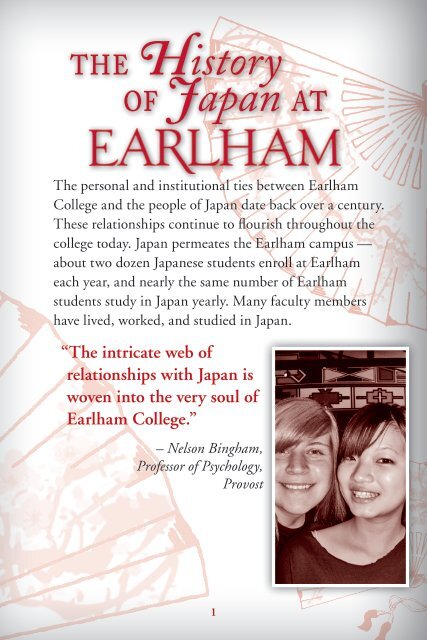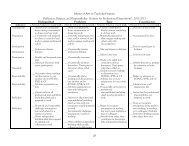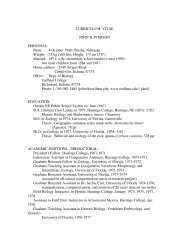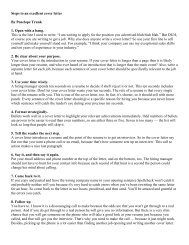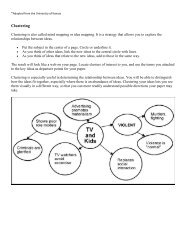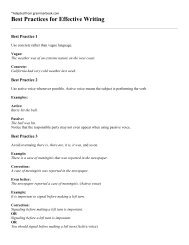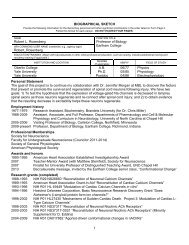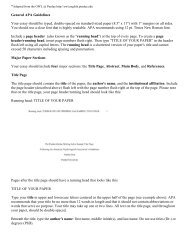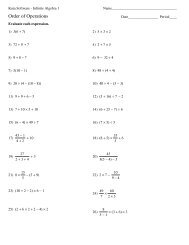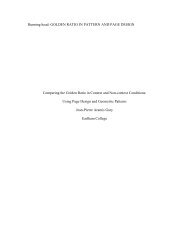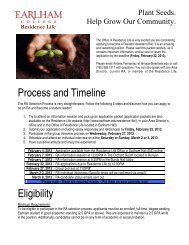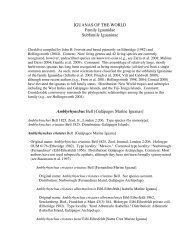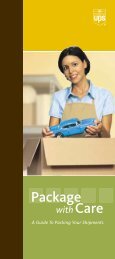The History of Japan at Earlham - Associated Colleges of the Midwest
The History of Japan at Earlham - Associated Colleges of the Midwest
The History of Japan at Earlham - Associated Colleges of the Midwest
Create successful ePaper yourself
Turn your PDF publications into a flip-book with our unique Google optimized e-Paper software.
<strong>the</strong> <strong>History</strong><br />
<strong>of</strong> <strong>Japan</strong> <strong>at</strong><br />
<strong>The</strong> personal and institutional ties between <strong>Earlham</strong><br />
College and <strong>the</strong> people <strong>of</strong> <strong>Japan</strong> d<strong>at</strong>e back over a century.<br />
<strong>The</strong>se rel<strong>at</strong>ionships continue to flourish throughout <strong>the</strong><br />
college today. <strong>Japan</strong> perme<strong>at</strong>es <strong>the</strong> <strong>Earlham</strong> campus —<br />
about two dozen <strong>Japan</strong>ese students enroll <strong>at</strong> <strong>Earlham</strong><br />
each year, and nearly <strong>the</strong> same number <strong>of</strong> <strong>Earlham</strong><br />
students study in <strong>Japan</strong> yearly. Many faculty members<br />
have lived, worked, and studied in <strong>Japan</strong>.<br />
“<strong>The</strong> intric<strong>at</strong>e web <strong>of</strong><br />
rel<strong>at</strong>ionships with <strong>Japan</strong> is<br />
woven into <strong>the</strong> very soul <strong>of</strong><br />
<strong>Earlham</strong> College.”<br />
– Nelson Bingham,<br />
Pr<strong>of</strong>essor <strong>of</strong> Psychology,<br />
Provost<br />
1
People<br />
Chuzo Kaifu<br />
1893<br />
Chuzo Kaifu became <strong>the</strong> first<br />
<strong>Japan</strong>ese man to earn a bachelor’s<br />
degree from <strong>Earlham</strong>. He<br />
returned to <strong>Japan</strong> and became<br />
<strong>the</strong> principal <strong>of</strong> <strong>the</strong> Tokyo<br />
Friends School, which was<br />
founded by Quaker missionary<br />
Joseph Cosand and his wife<br />
Sarah Ann, who were both<br />
<strong>Earlham</strong> students.<br />
1896<br />
May Morikawa<br />
became <strong>the</strong><br />
first <strong>Japan</strong>ese<br />
woman to earn a<br />
bachelor’s degree<br />
from <strong>Earlham</strong>.<br />
Quaker missionaries Joseph<br />
and Sarah Ann Cosand<br />
2
1911<br />
Yuri W<strong>at</strong>anabe, a gradu<strong>at</strong>e<br />
<strong>of</strong> Tsuda College, enrolled<br />
<strong>at</strong> <strong>Earlham</strong> <strong>at</strong> <strong>the</strong><br />
recommend<strong>at</strong>ion <strong>of</strong> her<br />
teacher and mentor, Michi<br />
Kawai. Yuri’s daughter<br />
Yoshiko enrolled <strong>at</strong><br />
<strong>Earlham</strong> in 1953.<br />
Yuri served as upperclass<br />
mentor to Bonner Fellers,<br />
who <strong>at</strong>tended <strong>Earlham</strong><br />
from 1914 – 1916. Fellers left<br />
<strong>Earlham</strong> to <strong>at</strong>tend West Point,<br />
but remained friends with Yuri. During<br />
<strong>the</strong> occup<strong>at</strong>ion, as a protégé <strong>of</strong> General<br />
Douglas MacArthur and one <strong>of</strong> his <strong>Japan</strong><br />
experts, Fellers landed in <strong>Japan</strong> with<br />
MacArthur and went searching for Yuri <strong>at</strong><br />
<strong>the</strong> first opportunity. Fellers is said to have<br />
based some <strong>of</strong> his advice to MacArthur<br />
on convers<strong>at</strong>ions with Yuri, including<br />
th<strong>at</strong> trying Emperor Hirohito for war crimes<br />
would be a grave mistake. In 1971, Fellers was<br />
awarded <strong>the</strong> Order <strong>of</strong> <strong>the</strong> Sacred Treasure.<br />
Yuri<br />
W<strong>at</strong>anabe<br />
Yuri W<strong>at</strong>anabe and<br />
daughter Yoshiko<br />
Bonner Fellers<br />
3
1917<br />
Es<strong>the</strong>r Rhoads, who l<strong>at</strong>er became tutor to<br />
<strong>the</strong> <strong>Japan</strong>ese Crown Prince, gradu<strong>at</strong>ed<br />
from <strong>Earlham</strong>.<br />
1927<br />
Amid an <strong>at</strong>mosphere <strong>of</strong> anti-<strong>Japan</strong>ese<br />
sentiment in <strong>the</strong> U.S., <strong>Earlham</strong> students<br />
Es<strong>the</strong>r<br />
Rhoads raised money to send Wilfred V. Jones to<br />
study in <strong>Japan</strong> as a gesture <strong>of</strong> goodwill. Jones<br />
became <strong>the</strong> first American to study <strong>at</strong> Tokyo<br />
Imperial University (present-day University <strong>of</strong> Tokyo).<br />
D. Elton<br />
Trueblood<br />
1942-45<br />
Through <strong>the</strong> efforts <strong>of</strong> <strong>Earlham</strong> President<br />
William Dennis, <strong>the</strong>n-Stanford faculty<br />
member D. Elton Trueblood (who joined<br />
<strong>Earlham</strong> in 1946 and helped establish <strong>the</strong><br />
<strong>Earlham</strong> School <strong>of</strong> Religion), and <strong>Earlham</strong><br />
alumni Homer and Edna Morris (who were<br />
coordin<strong>at</strong>ing <strong>the</strong> work <strong>of</strong> <strong>the</strong> American<br />
Friends Service committee among<br />
<strong>Japan</strong>ese-Americans), arrangements were<br />
made for <strong>Japan</strong>ese-Americans to <strong>at</strong>tend<br />
college <strong>at</strong> <strong>Earlham</strong>, sparing <strong>the</strong>m from<br />
<strong>the</strong> internment camps.<br />
William Dennis<br />
4
1959<br />
Jackson Bailey, Class <strong>of</strong> 1950, received a<br />
Ph.D. from Harvard University under<br />
<strong>the</strong> mentorship <strong>of</strong> Pr<strong>of</strong>essor Edwin<br />
Reischauer (who l<strong>at</strong>er became U.S.<br />
Ambassador to <strong>Japan</strong>) and returned<br />
to <strong>Earlham</strong> as a pr<strong>of</strong>essor <strong>of</strong> history.<br />
A Quaker, Bailey did his altern<strong>at</strong>ive<br />
service as a cook in <strong>the</strong> U.S. Occup<strong>at</strong>ion<br />
forces in <strong>Japan</strong> after World War II.<br />
Jackson Bailey<br />
“Deeply impacted by his time in <strong>Japan</strong>, Bailey<br />
dedic<strong>at</strong>ed his life to improving rel<strong>at</strong>ions<br />
between <strong>Japan</strong>ese and Americans. In his<br />
over thirty years <strong>of</strong> labor, he did not quite<br />
succeed in cre<strong>at</strong>ing a world where war and<br />
its sorrows are impossible, but <strong>the</strong>re are<br />
certainly thousands <strong>of</strong> people on both sides<br />
<strong>of</strong> <strong>the</strong> Pacific for whom those things are now<br />
unthinkable, thanks to Jack’s efforts.”<br />
— Chuck Y<strong>at</strong>es,<br />
Pr<strong>of</strong>essor <strong>of</strong> <strong>History</strong>,<br />
Director Emeritus <strong>of</strong><br />
<strong>the</strong> Institute for<br />
Educ<strong>at</strong>ion on <strong>Japan</strong><br />
5
Landrum Bolling and Kazuya M<strong>at</strong>sumiya ’28,<br />
Yoshida Found<strong>at</strong>ion President<br />
1972<br />
Landrum Bolling, president <strong>of</strong> <strong>Earlham</strong> 1968-1973,<br />
received an honorary doctor<strong>at</strong>e from Waseda University.<br />
Bolling initi<strong>at</strong>ed <strong>Earlham</strong>’s intern<strong>at</strong>ional programming in<br />
1959. <strong>The</strong> same year, he hired Jackson Bailey and toge<strong>the</strong>r<br />
<strong>the</strong>y began building <strong>Earlham</strong>’s programs with <strong>Japan</strong>.<br />
1988<br />
Haruo Nishihara, president <strong>of</strong><br />
Waseda University, received an<br />
honorary doctor<strong>at</strong>e from <strong>Earlham</strong><br />
College.<br />
Haruo<br />
Nishihara<br />
6
Awards<br />
1946<br />
Wendell M. Stanley, Class <strong>of</strong><br />
1926, was awarded <strong>the</strong> Order<br />
<strong>of</strong> <strong>the</strong> Rising Sun, <strong>the</strong> second<br />
most prestigious n<strong>at</strong>ional<br />
decor<strong>at</strong>ion given by <strong>the</strong> <strong>Japan</strong>ese<br />
government. Stanley also<br />
received <strong>the</strong> Nobel Prize in<br />
Chemistry in 1946.<br />
Wendell M. Stanley<br />
1958<br />
Gordon T. Bowles, Class <strong>of</strong> 1925<br />
(Harvard Ph.D., anthropology),<br />
was awarded <strong>the</strong> Order <strong>of</strong> <strong>the</strong><br />
Rising Sun. As an employee <strong>of</strong><br />
<strong>the</strong> St<strong>at</strong>e Department, in 1942<br />
Bowles was responsible for<br />
writing a paper outlining <strong>the</strong><br />
administr<strong>at</strong>ive structure<br />
for <strong>the</strong> U.S. Occup<strong>at</strong>ion in postwar<br />
<strong>Japan</strong>.<br />
7
Waseda University<br />
exchange students<br />
1988<br />
Jackson Bailey received <strong>the</strong> Order <strong>of</strong> <strong>the</strong> Sacred Treasure.<br />
Bailey taught in <strong>Earlham</strong>’s <strong>History</strong> Department (1959-<br />
1993) and was instrumental in developing <strong>Earlham</strong>’s<br />
<strong>Japan</strong>ese Studies Program. He received an honorary<br />
doctor<strong>at</strong>e from Waseda University in 1990, and <strong>the</strong><br />
Outstanding Alumni Award from <strong>Earlham</strong> in 1996.<br />
1999<br />
Barbara Ruch, Class <strong>of</strong> 1954, was awarded <strong>the</strong> Order <strong>of</strong><br />
<strong>the</strong> Precious Crown with Butterfly Crest. Ruch is Pr<strong>of</strong>essor<br />
Emerita <strong>of</strong> <strong>Japan</strong>ese Liter<strong>at</strong>ure and Culture <strong>at</strong> Columbia<br />
University and received <strong>the</strong> Outstanding Alumni Award<br />
from <strong>Earlham</strong> in 2003.<br />
8
2004<br />
<strong>Earlham</strong>’s Institute for<br />
Educ<strong>at</strong>ion on <strong>Japan</strong>, under<br />
<strong>the</strong> direction <strong>of</strong> Pr<strong>of</strong>essor<br />
Chuck Y<strong>at</strong>es, received<br />
<strong>the</strong> Foreign Minister’s<br />
Commend<strong>at</strong>ion from <strong>the</strong><br />
Government <strong>of</strong> <strong>Japan</strong> as<br />
Foreign Minister’s Commend<strong>at</strong>ion<br />
and Commemor<strong>at</strong>ive Cup<br />
part <strong>of</strong> 150 years <strong>of</strong> <strong>Japan</strong>ese - U.S. rel<strong>at</strong>ions. <strong>The</strong> award was<br />
given in recognition <strong>of</strong> <strong>the</strong> commitment <strong>of</strong> <strong>the</strong> Institute to<br />
educ<strong>at</strong>ional, cultural, and community programs to increase<br />
understanding between <strong>Japan</strong>ese and Americans.<br />
Judy and Richard Wood<br />
2009<br />
Richard Wood, pr<strong>of</strong>essor<br />
emeritus <strong>of</strong> philosophy<br />
(1966-1980) and former<br />
<strong>Earlham</strong> College President<br />
(1985-1996) was honored<br />
with <strong>the</strong> Order <strong>of</strong> <strong>the</strong><br />
Rising Sun, Gold and Silver<br />
Star, for his outstanding<br />
contributions to <strong>the</strong><br />
promotion <strong>of</strong> educ<strong>at</strong>ional<br />
and cultural exchange<br />
between <strong>Japan</strong> and <strong>the</strong><br />
United St<strong>at</strong>es.<br />
9
Programs<br />
1963<br />
With <strong>the</strong> assistance <strong>of</strong> U.S. Ambassador to <strong>Japan</strong> Edwin<br />
Reischauer, and under <strong>the</strong> direction <strong>of</strong> Jackson Bailey,<br />
<strong>Earlham</strong> began a student and faculty exchange program<br />
between Waseda University, one <strong>of</strong> <strong>Japan</strong>’s premier<br />
universities, and <strong>the</strong> Gre<strong>at</strong> Lakes<br />
<strong>Colleges</strong> Associ<strong>at</strong>ion (GLCA) and<br />
Associ<strong>at</strong>ed <strong>Colleges</strong> <strong>of</strong> <strong>the</strong> <strong>Midwest</strong><br />
(ACM). To d<strong>at</strong>e, about 1,500 U.S.<br />
students have studied <strong>at</strong> Waseda<br />
and 1,000 Waseda students have<br />
studied <strong>at</strong> GLCA/ACM campuses<br />
through <strong>the</strong> <strong>Japan</strong> Study program.<br />
Over 300 faculty members have<br />
particip<strong>at</strong>ed in educ<strong>at</strong>ional<br />
exchanges and pr<strong>of</strong>essional<br />
development opportunities linking<br />
<strong>the</strong>se universities.<br />
“<strong>The</strong>re is no telling it all — on this form or on<br />
a ream <strong>of</strong> paper. <strong>Japan</strong> Study simply changed<br />
my life as only a true awakening can. I saw new<br />
ways. I felt new longings. I became a person<br />
different from <strong>the</strong> one I had been.”<br />
— alumnus <strong>of</strong> <strong>Japan</strong> Study 1963-1964<br />
10
1964<br />
<strong>Japan</strong>ese language instruction began<br />
<strong>at</strong> <strong>Earlham</strong>.<br />
1968<br />
<strong>Earlham</strong> began a program to place<br />
recent college gradu<strong>at</strong>es in middle<br />
and high schools in nor<strong>the</strong>rn <strong>Japan</strong><br />
as Assistant Language Teachers.<br />
Originally a form <strong>of</strong> altern<strong>at</strong>ive<br />
service for conscientious objectors,<br />
this program was a precursor to <strong>the</strong> well-known <strong>Japan</strong>ese<br />
government-run JET program.<br />
11
1973<br />
<strong>Earlham</strong> signed an exchange agreement with <strong>the</strong> City<br />
<strong>of</strong> Morioka in nor<strong>the</strong>rn <strong>Japan</strong> and in 2003 signed an<br />
agreement with Iw<strong>at</strong>e University. Each year, through<br />
<strong>Earlham</strong>’s Studies in Cross-cultural Educ<strong>at</strong>ion (SICE)<br />
program, a faculty member accompanies <strong>Earlham</strong> students<br />
for <strong>the</strong> fall semester program in Morioka. Through<br />
homestays, teaching English in local schools, and courses<br />
<strong>at</strong> Iw<strong>at</strong>e University, students learn about <strong>Japan</strong>ese and<br />
Americans not only from <strong>the</strong>ir “mutual joys, but also<br />
mutual frustr<strong>at</strong>ions,” as one former faculty leader observed.<br />
<strong>The</strong> 1979 SICE<br />
group was introduced<br />
to <strong>the</strong> Kurosawas,<br />
accomplished koto<br />
players living in<br />
Morioka. Mrs.<br />
Kurosawa’s f<strong>at</strong>her was<br />
<strong>the</strong>n <strong>the</strong> president <strong>of</strong><br />
Iw<strong>at</strong>e University. <strong>The</strong>ir<br />
daughter Yuki l<strong>at</strong>er<br />
studied <strong>at</strong> <strong>Earlham</strong> and now serves as <strong>the</strong> SICE Program<br />
Associ<strong>at</strong>e in <strong>Japan</strong>.<br />
Today, ties remain deep with Morioka and it is not unusual<br />
for host families to visit <strong>Earlham</strong> in order to <strong>at</strong>tend <strong>the</strong><br />
gradu<strong>at</strong>ion <strong>of</strong> former host students.<br />
12
1974<br />
<strong>The</strong> <strong>Japan</strong>ese Studies Program began conferring <strong>the</strong><br />
Bachelor <strong>of</strong> Arts degree, and it continues to be one <strong>of</strong><br />
<strong>Earlham</strong>’s flagship programs.<br />
1986<br />
<strong>Earlham</strong> cre<strong>at</strong>ed <strong>the</strong> Institute for Educ<strong>at</strong>ion on <strong>Japan</strong>,<br />
responsible for all <strong>Japan</strong>-rel<strong>at</strong>ed outreach activities<br />
conducted by <strong>the</strong> College. Among its most important<br />
activities has been K-12 outreach programs for Indiana<br />
teachers in cooper<strong>at</strong>ion with <strong>the</strong> Indiana St<strong>at</strong>e Department<br />
<strong>of</strong> Educ<strong>at</strong>ion. In large part because <strong>of</strong> <strong>Earlham</strong>’s efforts,<br />
Indiana is known for its exemplary high school educ<strong>at</strong>ion<br />
in <strong>Japan</strong>ese language.<br />
13
1999<br />
Hamano Takao, Tokyo Friends<br />
School faculty member, began<br />
an exchange program with<br />
<strong>Earlham</strong> by spending three<br />
weeks on campus. In 2000 Paul<br />
and Margie Lacey <strong>of</strong> <strong>Earlham</strong>’s<br />
English Department spent three<br />
weeks <strong>at</strong> Tokyo Friends School.<br />
<strong>The</strong> exchange continues in both<br />
directions.<br />
1994<br />
<strong>Earlham</strong> assisted Richmond<br />
in signing a sister-city<br />
exchange agreement with<br />
Daito-cho (now Unnan-shi)<br />
in Shimane Prefecture in<br />
Southwestern <strong>Japan</strong>, where<br />
<strong>Earlham</strong> students have been<br />
particip<strong>at</strong>ing in a one-month<br />
rural homestay program<br />
since 1986. Each August a<br />
group <strong>of</strong> Unnan students<br />
and teachers visit Richmond,<br />
and business and sister-city<br />
deleg<strong>at</strong>ions from Richmond<br />
<strong>of</strong>ten visit Unnan.<br />
14
2010<br />
<strong>Earlham</strong> hosted <strong>the</strong> <strong>Japan</strong>-America Student Conference,<br />
a one-month program th<strong>at</strong> brings nearly 80 students<br />
from universities across <strong>Japan</strong> and <strong>the</strong> United St<strong>at</strong>es<br />
toge<strong>the</strong>r each year to discuss some <strong>of</strong> <strong>the</strong> most important<br />
topics facing <strong>the</strong> two n<strong>at</strong>ions and <strong>the</strong> world. <strong>The</strong> annual<br />
conference began in 1934 with a group <strong>of</strong> <strong>Japan</strong>ese students<br />
who hoped to improve <strong>Japan</strong>-U.S. rel<strong>at</strong>ions.<br />
“<strong>The</strong>re is a well-worn p<strong>at</strong>h between <strong>Earlham</strong><br />
and <strong>Japan</strong>. Study abroad, May Term programs,<br />
and summer research trips take students and<br />
faculty to <strong>Japan</strong>. In addition, <strong>Earlham</strong> draws<br />
many <strong>Japan</strong>ese students to campus for <strong>the</strong>ir<br />
college educ<strong>at</strong>ion. Indeed <strong>the</strong> next best thing<br />
to being in <strong>Japan</strong> is being <strong>at</strong> <strong>Earlham</strong>.”<br />
— Gary DeCoker, Pr<strong>of</strong>essor, <strong>Japan</strong>ese Studies;<br />
Director, Institute for Educ<strong>at</strong>ion on <strong>Japan</strong><br />
15
For fur<strong>the</strong>r inform<strong>at</strong>ion contact:<br />
<strong>Japan</strong>ese Studies<br />
<strong>Earlham</strong> College<br />
765/983-1224<br />
japanstu@earlham.edu<br />
Historical photos are courtesy<br />
<strong>of</strong> <strong>the</strong> <strong>Earlham</strong> College Archives.<br />
16


